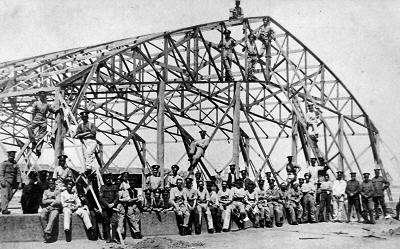|
|
The Channel Islands and the Great War
|
|
The French
Seaplane Base in Guernsey
|
|
Guernsey newspapers of 1917-18 carry no mention of the
fact that there was an active French seaplane base at
the Castle Emplacement during that period. Davis (1)
states that this was because of the "mild form
of voluntary censorship instituted at the out break of
the war". However Davis (1),
in a series of articles written after the war, describes
several visits by airships and seaplanes in 1916 and early
1917. These were the forerunners of the establishment
of a seaplane base, agreed by the French and British governments
but run by the Aviation Maritime Française.
The stretch of water between Guernsey and England was
the scene of much German submarine activity, so a convoy
system had been introduced. Ships for English ports were
formed into convoys west of the Scilly Isles and were
escorted by British naval ships up the channel, travelling
close to the English coast. Similarly, vessels for French
ports assembled at Ushant and were escorted by French
warships.
|
|
The journey from Ushant to Calais can be made within sight
of the French coast except for the portion between Tréguier,
in Brittany, and Guernsey.
There were already aviation centres in Cherbourg and Tréguier,
and a station in Guernsey established a link between the two.
The Guernsey station would initially form an annexe of the
Cherbourg Aviation Centre, and was to receive a permanent section
of two or three seaplanes, each commanded by a Pilot Officer,
and with an observer. Other personnel assigned to the base were
to be a Second Master Mechanic, three Quartermaster Specialised
mechanics, three Seaman Mechanics, one Seaman Radio TSF, one
Seaman Gunner, one Seaman Specialised, one Seaman Carpenter
and one Seaman Signaller. There were also to be two or three
non - commissioned pilots. The Guernsey station was to have
responsibility for patrolling the area of sea between the island
and Tréguier, but they also covered the seas around Alderney
and Les Casquets along with British, French, and later American,
seaplanes based in Cherbourg.
The Model Yacht Pond was drained to form a site for one of
the four hangars, and a double row of accommodation huts for
the aviators was built between the Harbour and the Model Yacht
Pond. The hangers were Bessoneaus, built of metal frames bolted
together, then covered with heavy green canvas tied to the framework
through brass eyelets. Special buildings for aviation fuel,
oil, and storage for the station's reserve of ten bombs and
2,000 machine gun magazines were also required. The work, including
the installation of water supplies and electric light, was carried
out by the Guernsey Company of Royal Engineers, "assisted
by a few French bluejackets", under the supervision
of Ensign de Vaisseau Séguier then Ensign de Vaisseau
Dauvin.
It was officially opened in August 1917, with M. le Cour-Grandmaison
as Commandant. There were ten or twelve seaplanes based on the
island, with between 6 and 10 pilots available at different
times. Officers at the base included First Lieutenant Yves Maheas,
pilot, Lieutenants Réné de St Maurice, pilot,
Henri Boissan, observer, and Marcel Le Parmentier, observer,
Second Lieutenant Maurice de Rodellec du Porzic, observer, and
Engineer Officer Dousselin.
 |
When the work was completed, a party of about 100 men,
consisting of Officers, Petty Officers (who were employed
as observers) and mechanics also arrived from Cherbourg,
on the barge Corail, which was pulled across by an armed
tug.
Regular patrols were established immediately, with seaplanes
working in pairs from daylight to dark. It was originally
intended that the seaplanes, or hydravions, would come
ashore on specially strengthened ramps previously used
for launching boats, but it was eventually decided that
they would be lifted out by cranes instead. Initially
they used pigeons trained to carry back information, but
soon all seaplanes were equipped with radios.
The planes themselves are described by Davis as being
"mainly biplanes with a single boat shaped float,"
though a couple of triplanes were brought over in 1918
"but were not much used." The biplanes
were Tellier
200s and FBAs, as the technical specification and
date match the description in Davis. These were 200hp
single engined hydravions, carrying two 52kg bombs, and
could be fitted with a machine gun at the front of the
fuselage. They could carry a crew of two or three men
on a four hour patrol at 130Km/h and could climb to 2,000m
in about 16 minutes at full power.
|
Page 2  |
|
|